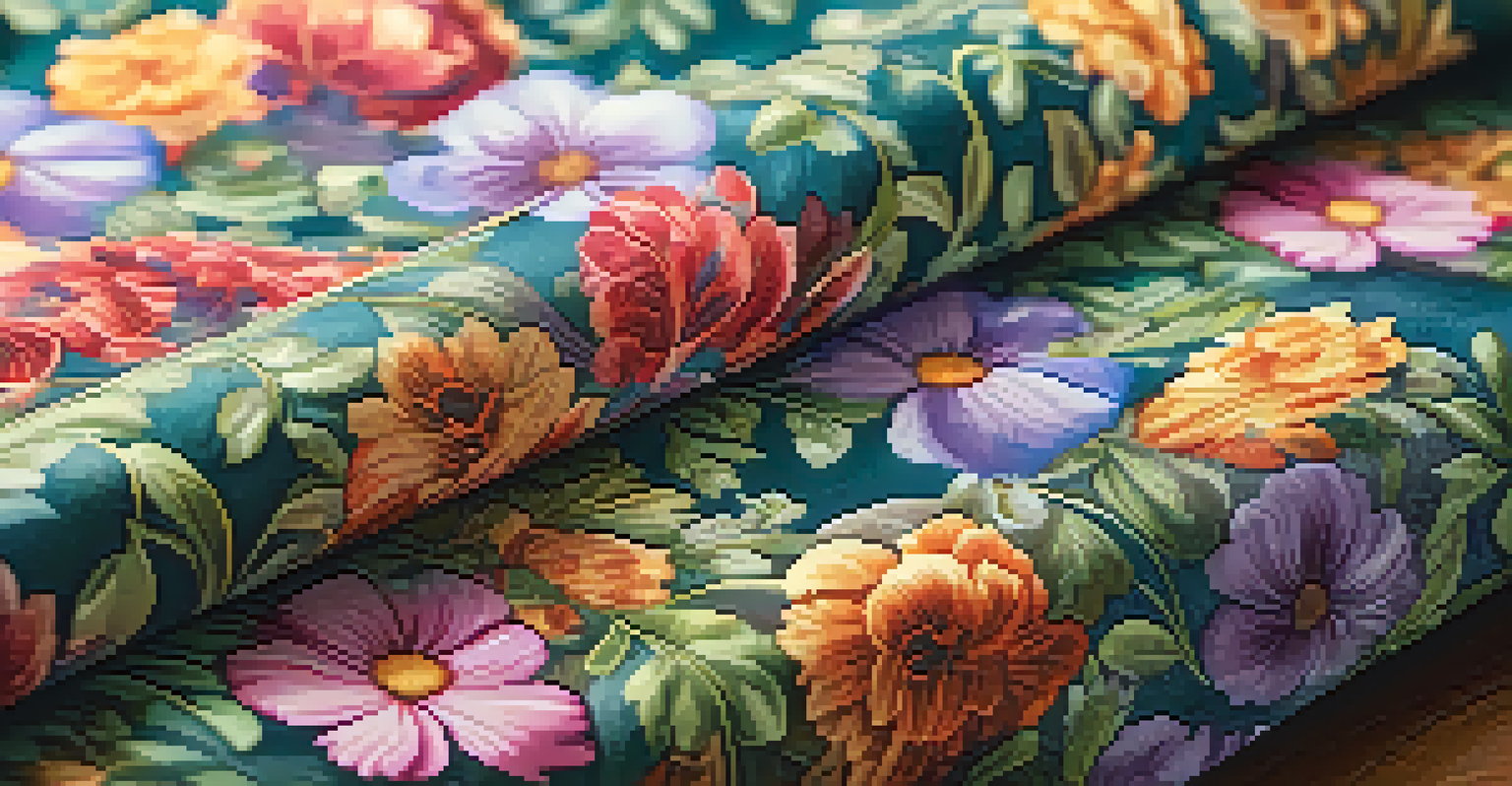The Rise of Digital Fabric Printing in Fashion Design

Understanding Digital Fabric Printing: A Game Changer
Digital fabric printing has revolutionized the way fabrics are designed and produced. Unlike traditional printing methods, which often rely on screens and stencils, digital printing uses advanced technology to apply ink directly onto fabric. This innovative approach not only speeds up production but also allows for greater design flexibility, enabling designers to experiment with intricate patterns and vibrant colors.
The future of fashion is not just about clothing; it's about the stories we tell through our designs and the technology that brings those stories to life.
Imagine a world where designers can bring their wildest ideas to life in just a matter of hours instead of weeks. That’s the beauty of digital fabric printing; it empowers creativity by making it easier to test and modify designs. With just a few clicks, a designer can create a unique pattern and see it printed on fabric, allowing for immediate feedback and adjustments.
As this technology continues to evolve, it opens up exciting possibilities for the fashion industry. From custom prints to small-batch production, digital fabric printing is helping brands cater to diverse consumer demands while reducing waste, which is crucial in today’s eco-conscious market.
The Benefits of Digital Printing in Fashion
One of the standout benefits of digital fabric printing is its ability to produce short runs of fabric without the financial burden typically associated with traditional methods. This means that emerging designers can create limited-edition collections without the risk of overproduction. They can test the market with unique pieces that resonate with consumers, all thanks to the efficiency of digital printing.

Additionally, digital printing allows for a vast array of color options and intricate designs. Designers can now create hyper-detailed graphics and bold patterns that were once impossible to achieve with older printing techniques. This freedom to explore and innovate leads to a more vibrant and diverse fashion landscape, where creativity knows no bounds.
Digital Printing Boosts Creativity
Digital fabric printing allows designers to rapidly create and modify intricate designs, enhancing creative possibilities.
Moreover, digital printing is a more sustainable option, as it uses less water and energy compared to traditional methods. This aligns with the growing demand for eco-friendly practices in the fashion industry, making it an attractive choice for brands looking to reduce their environmental impact.
How Digital Printing is Shaping Consumer Trends
As consumers become more informed and conscious about their choices, they are gravitating towards brands that offer unique and personalized products. Digital fabric printing fits this trend perfectly, as it enables brands to provide customized designs that cater to individual preferences. Whether it’s a bespoke dress or a one-of-a-kind accessory, this technology allows consumers to express their personal style.
Sustainability isn't just a trend; it's a responsibility that we must take seriously as we create the future of fashion.
Furthermore, the rise of e-commerce has amplified the demand for distinctive and innovative fashion items. Digital printing facilitates rapid prototyping, meaning brands can quickly roll out new designs based on current trends and consumer feedback. This agility not only keeps brands relevant but also enhances customer engagement by offering fresh and exciting options.
In essence, digital printing is not just a manufacturing technique; it’s a bridge connecting designers and consumers. By embracing this technology, fashion brands can cater to evolving consumer preferences, ultimately leading to a more dynamic and responsive market.
Case Studies: Brands Leading the Digital Printing Revolution
Several fashion brands are at the forefront of the digital fabric printing movement, showcasing how this technology can elevate design and production. For instance, brands like Nike have successfully implemented digital printing to create personalized footwear, allowing customers to select colors and patterns that reflect their unique style. This not only enhances the customer experience but also reinforces brand loyalty.
Another notable example is the luxury brand Stella McCartney, which has embraced digital printing to produce sustainable and stylish collections. By utilizing eco-friendly inks and fabrics, the brand not only reduces its carbon footprint but also sets a standard for responsible fashion. Their commitment to innovation and sustainability resonates with consumers who prioritize ethical choices.
Sustainability in Fashion Production
This printing method is more eco-friendly, using less water and energy, aligning with the industry's shift towards sustainable practices.
These case studies highlight the versatility of digital fabric printing across various market segments, from high fashion to activewear. As more brands recognize the potential of this technology, we can expect to see even more creative applications in the future.
Challenges Facing the Digital Printing Industry
Despite its many advantages, digital fabric printing is not without challenges. One of the primary concerns is the initial investment required for high-quality digital printing equipment. While costs have decreased over the years, smaller brands may still struggle to afford the technology necessary for large-scale production.
Additionally, there can be a steep learning curve when transitioning from traditional methods to digital printing. Designers and manufacturers need to adapt to new workflows and understand the intricacies of digital technology to fully leverage its potential. This transition period can be daunting but is essential for remaining competitive in a rapidly evolving industry.
Lastly, as demand for digital printing grows, so does the need for skilled technicians who can operate and maintain the machinery. The industry must invest in training and education to ensure that talent is available to support this burgeoning technology, paving the way for future innovation.
The Future of Digital Fabric Printing in Fashion
Looking ahead, the future of digital fabric printing in fashion seems bright and promising. As technology continues to advance, we can expect even more sophisticated printing techniques that enhance quality and reduce production times. Innovations such as 3D printing and smart textiles may soon merge with digital fabric printing, opening up a whole new realm of possibilities for designers.
Moreover, sustainability will likely remain a key focus area. As consumers demand more eco-friendly options, digital printing's inherent efficiency will play a vital role in helping brands achieve their sustainability goals. The ability to produce on-demand and reduce waste aligns perfectly with the shift towards more responsible fashion practices.
Personalization Drives Consumer Trends
As consumers seek unique products, digital printing enables brands to offer customized designs that cater to individual preferences.
Ultimately, the rise of digital fabric printing is not just a trend; it's a fundamental shift in the fashion industry. By embracing this technology, brands can enhance creativity, streamline production, and cater to the evolving needs of consumers, ensuring a vibrant and sustainable future for fashion.
Conclusion: Embracing Change in Fashion Design
In conclusion, digital fabric printing is transforming the fashion landscape, making it more innovative, sustainable, and consumer-focused. As we’ve explored, the benefits of this technology are manifold, from enabling unique designs to promoting environmentally conscious practices. The challenges, while notable, can be overcome with the right investment in technology and talent.
Fashion designers and brands that embrace digital printing will not only find themselves at the forefront of creativity but also better positioned to meet the demands of a diverse and discerning consumer base. The future of fashion design is undoubtedly intertwined with the advancements in digital printing, and it’s exciting to think about what lies ahead.

As we move forward, the key takeaway is to remain open to change and innovation. By harnessing the power of digital fabric printing, designers can push boundaries, redefine norms, and ultimately create a fashion industry that is as dynamic as the consumers it serves.